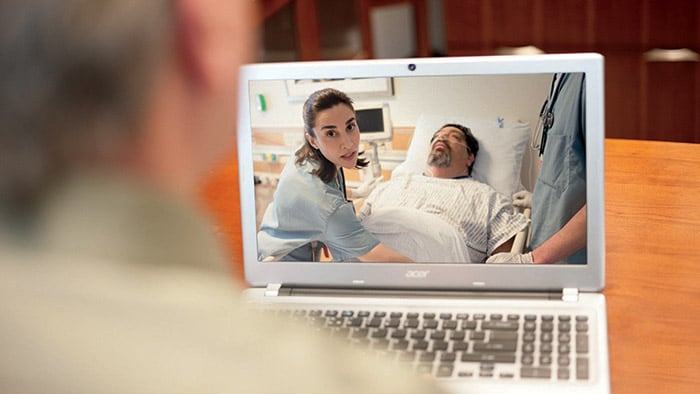Why collaboration is key to addressing staff shortages in healthcare – Q&A with Prof. Jaroslaw J. Fedorowski
Oct 03, 2023 | 5 minute read
Shortages of qualified workers are a top concern for healthcare leaders worldwide. In a series of articles, we have invited healthcare leaders from different parts of the world to share how they are innovating care delivery to attract, empower and retain staff, and to provide high-quality patient care in more efficient ways. For this edition, we spoke with Jaroslaw J. Fedorowski, Univ. Prof., MD, PhD, MBA, FACP, FESC, who is the President and CEO of the Polish Hospital Federation – an umbrella organization that represents over 500 hospitals nationwide, and which is a full member of the European Hospital Federation HOPE and the International Hospital Federation IHF.

Q: Prof. Fedorowski, to start off, could you outline some of the staffing challenges that hospitals in Poland are facing?
A: There are several, and many of them have to do with an uneven distribution of resources. Geographically, healthcare professionals in Poland gravitate towards working in large city hospitals. In county hospitals, it’s a challenge to find enough qualified staff – especially nurses. Poland has slightly less than the EU average number of doctors, but a well below-average number of nurses.
On top of that, hospitals are competing with other healthcare organizations for staff, because our healthcare system is still quite fragmented. We are currently seeing an outflow of hospital workers into ambulatory care facilities, where they typically get to work shorter hours under less stressful conditions. Hospital leaders also need to take into consideration that younger healthcare professionals are entering the field with expectations about work-life balance that are different from older generations.
I am optimistic, though, that through collaboration we can address these challenges. Hospital managers in Poland tend to be very entrepreneurial and creative, and we are seeing many exciting developments in both technology innovation and human resource management.
“Healthcare’s aging workforce is often considered a challenge. But I like to think of it as an opportunity.”

Jaroslaw J. Fedorowski, Univ. Prof., MD, PhD, MBA, FACP, FESC
President and CEO of the Polish Hospital Federation
Q: Let’s unpack some of these challenges and developments. You called out nursing shortages in particular. What are hospitals in Poland doing to attract and retain nurses? Q: That is an interesting observation. What else can hospital leaders do to support and retain older staff members? Q: What about younger healthcare professionals? How can hospitals continue to be an attractive employer for them?
A: For a number of years, the nursing profession was not strongly promoted in Poland, and working conditions were not optimal either. Those conditions are now improving. Not only are nurses compensated better, but they are also becoming more educated and specialized, and they have started to enjoy opportunities for professional development that were not present a few years ago.
Their standing in healthcare has also changed for the better. In the past, nurses basically performed what the physician ordered them to do. Now, they are really becoming partners on a care team. I think this is an essential part of modern human resource management: involving staff, making them feel valued. Another aspect of that is to look for ways of helping people focus on what they do and enjoy best. For example, we have a relatively new profession in Poland called (in a direct translation) a ‘medical caregiver’, who assists patients with their daily activities. This allows nurses to concentrate on their nursing duties.
Assistive technology can play a big part in improving working conditions for nurses as well, by making it less physically demanding. This doesn’t always have to be the most sophisticated technology. Something as simple as equipment that helps nurses to lift patients can make a huge difference in making their work more effective, ergonomic, and pleasant. This kind of assistive technology also enables older nurses to keep working longer. We often talk about the aging workforce in healthcare as a challenge, but I like to think of it as an opportunity. There is a silver medical economy waiting to be unlocked.
A: First, I think it is important we change our perspective on what it means to have an aging workforce. Clearly, the average age of doctors and nurses is getting higher. But rather than lamenting this fact, we should embrace it. If our goal as a society is to live longer and more productive lives – through better and more preventative healthcare – then medical professionals are going to live longer as well. So the question should really be: how can we support these experienced professionals and keep them in healthcare?
I already mentioned one type of technology that can support nurses, but there are many other forms of assistive technology as well. For example, robots could support them in dispensing and distributing medication. All of this would allow older nurses, who are perhaps not as physically strong anymore, to be as effective as their younger colleagues. And there may also be opportunities for experienced staff members to provide training and education, or to work on a consulting basis, away from the bedside.
A: Just like we are learning how to keep older staff engaged, we must also take the time to listen to younger healthcare professionals and understand what they value. We know that work-life balance is important to them, so that is something we should organize hospital care around better. For example, some medics may enjoy working seven-days shifts and then take a block of days off, while those with kids may prefer a regular weekday schedule. If we can give them that kind of flexibility, it becomes more attractive for them to work in a hospital.
Environmental sustainability is also something that younger generations in particular value. They may be happier and more motivated to work in a green hospital environment that is environmentally friendly. [Editor’s note: this aligns with findings from the Philips Future Health Index 2023 report, which showed that more than one-third (35%) of younger healthcare professionals are looking for employers who have strong sustainability policies in place.]

Q: You mentioned the role of technology in assisting healthcare professionals. What other opportunities do you see for technology to make healthcare a more attractive field to work in? Q: Do you also see a role for technology in connecting doctors in urban hospitals to county hospitals, where specialist staff may be in short supply? Q: You alluded to the importance of collaboration across the healthcare ecosystem. What does successful collaboration look like to you, and how is the Polish Hospital Federation supporting it?
A: We have seen quite a few successful initiatives in Poland to digitalize healthcare and facilitate the exchange of medical information. We are actually the country where the most prescriptions now take place electronically, partly owing to the COVID-19 pandemic. Meanwhile, electronic referrals have stimulated a move towards better care coordination.
We have also seen spectacular developments in robotic surgery in Poland. Robots are not replacing surgeons, but augmenting their skills – for example, by reducing human imperfections in hand precision. For that same reason, I am a big enthusiast of voice recognition technology. Again, it will not replace the role of the physician, but it will augment their skills and make their work more attractive. Speaking as a physician: my goal is to spend the least amount of time on inputting data into a computer, and to spend as much time as I can on examining and performing procedures, and on talking to the patient and their family. I would love for voice recognition technology to automatically transcribe conversations with patients and capture all relevant information in the EMR, so that I do not need to perform this manually. This could make a big difference for senior staff members in a hospital as well, because manual data entry via a keyboard may be particularly cumbersone for them.
A: Yes, absolutely. We can take inspiration from the US, where we have seen the rise of virtual hospitals and remote care management. Instead of staffing an entire hospital with subspecialty physicians, we could have general physicians or hospitalists who manage patient care and who consult specialized physicians in other locations when needed. Sometimes a virtual consultation may be sufficient, and sometimes the subspecialty physician may need to come in to perform a procedure on site. Eventually we may have physicians who are either hospitalists or proceduralists.
Similarly, I foresee the development of more applications that will help doctors collaborate virtually. For example, in oncology, we have multi-disciplinary tumor board meetings which are mandatory for the assessment of patients with a new diagnosis of cancer. Thanks to modern technology, we can now connect and review a case without everyone having to be in the same room. And as a result of the pandemic, patients have also become familiar with telemedicine – which is important, because you need patient acceptance of these new technologies as well.
A: As I mentioned, the key challenge lies with the coordination of care, to create optimal value for patients throughout their care journey. This should be our ultimate goal, and it is a big focus for the Polish Hospital Federation and our partners. We are supporting the development of coordinated care to create better collaboration across the entire cycle of patient care. For example, patients who suffer a heart attack are now being taken care of by different providers working together in a coordinated care system. We have recently also established a national oncology network in Poland. And Poland is now stepping up with coordinated care programs in primary care, where patients are assigned a care coordinator who assists them throughout their care journey. So, I think these are all steps in the right direction.
Ultimately, we are a big proponent of value-based care. I do not think anyone in the world has been able to introduce this at full scale, but I believe there is really no better model. We have proposed that Poland moves towards value-based care by organizing coordinated care consortia that would be competing based on care outcomes. Optimal results can only be achieved if healthcare providers cover the entire cycle of patient care. That would also help us apply a proper amount of staffing and resources to each segment of healthcare. As a result, instead of different providers competing with each other based on the prices of their services, we would have coordinated care consortia competing for the value they provide to their patients as well as their staff.
Closer collaboration within the healthcare system is really going to be essential. That is why, at the Polish Hospital Federation, we work with many different stakeholders, including hospital decision makers, government bodies, trade unions, producers of medical equipment, start-ups, and educational partners. I believe international cooperation is also very important, which is why we value ongoing dialogue and knowledge exchange through the European Hospital Federation and the International Hospital Federation. By creating opportunities for networking and education, we can all learn from each other and find new solutions for alleviating staffing shortages.
This conversation has been edited for flow and clarity.
Share this page with your network







